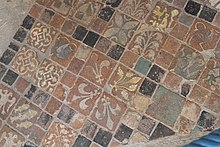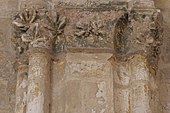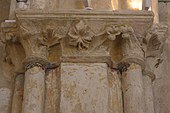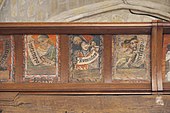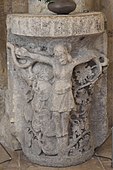St-Léonard (Croissy-sur-Seine)
St-Léonard (also Chapelle Saint-Léonard et Saint-Martin ) in Croissy-sur-Seine , a commune in the Yvelines department in the French region of Île-de-France , was built and served in the Gothic style at the beginning of the 13th century until it was profaned as a Catholic parish church in 1882 . In 1942, the building was added to the list of architectural monuments in France as Monument historique .
history
Already in Carolingian times there was probably a simple chapel dedicated to Saint Martin of Tours on the site of the Chapelle Saint-Léonard , which was elevated to a parish church under the rule of the Carolingians . In 1211, the Bishop of Paris subordinated the church to the Augustinian Canons in Saint-Léonard-de-Noblat , which established a priory in Croissy and furnished the church there with relics of its patron saint and founder of the monastery. As a result, the church took over that of St. Leonhard of Limoges as the second patronage and became the destination of a much-visited pilgrimage . In the middle of the 17th century , extensive construction and renovation work took place in the church under the then landlord of Croissy, François de Patrocles, and with the support of Anna of Austria , the mother of Louis XIV . Between 1645 and 1655 a sacristy and two private chapels were added to the choir and a wooden gallery was built in the west of the nave . In the 1730s the southern side chapel was enlarged and the floor in the entire interior was 70 cm higher, with numerous old grave slabs being reused as flooring.
In 1882 the church, which had become too small, was profaned after a new parish church had been built in what is now the center of Croissy. In 1896 the painter Théophile Poilpot acquired the former church and set up his studio and a small museum there. He had floor tiles from the 14th and 15th centuries laid in the choir, in the south side chapel he had a fireplace and a portal framing in the style of the Flamboyant Gothic installed and on the gallery balustrade he had 14 panel paintings ( closoirs ) from the 15th century painted on poplar wood Attach the century. After Poilpot's death, the former church changed hands several times until it bought the parish in 1976. Since the 1980s , exhibitions and concerts have been held in the building, which has been called Chapelle Saint-Léonard ever since .
architecture
Exterior construction
The west facade is crowned by a slate-covered wooden roof turret and flanked on the south side by a round stair tower. The pointed arched portal surrounded by archivolts is cut into a narrow protrusion of the wall covered with stone slabs , above which a round window opens. Massive buttresses reinforce the outer walls of the choir and nave .
inner space
The single nave nave is divided into three bays and is covered by a ribbed vault. The polygonal choir has a six-part rib vault, the keystone of which is decorated with a relief of a head. The vault ribs rest with leaf in the choir on slender columns capitals , in the nave they are pilasters added.
Leaded glass window
The stained glass windows in the choir and the round window on the west facade depicting the crucifixion of Christ are imitations of medieval windows. The modern windows in the nave were created by Emmanuel Chauche in 1984.
Liter funéraire
Slightly above the base of the vault there is a painted black ribbon, a liter funéraire (mourning ribbon), with the coat of arms of the Patrocles family, who were the lords of Croissy in the 17th century.
Panel paintings ( closoirs ) on the gallery parapet
The 14 panel paintings on the gallery parapet are dated to the 15th century. They are originally from Lombardy and are attributed to Bonifacio Bembo . In five pictures, the people are framed by columns and multi-pass arches. Eight pictures depict heroes of Roman mythology and medieval fable poetry holding banners with their names in their hands. One picture shows a person emerging from a flower with a branch with fruits in hand.
Further equipment
- The relief depicting Christ on the cross from the 13th century was probably acquired by Théophile Poilpot.
- The grave slabs for François-Louis de Patrocles († 1651) and Marguerite de Patrocles († 1746) were attached to the north choir wall.
literature
- Jean-Marie Pérouse de Montclos (ed.): Le Guide du Patrimoine. Île-de-France . Hachette, 2nd edition, Paris 1994, ISBN 2-01-016811-9 , p. 204.
- Georges Poisson (ed.): Dictionnaire des Monuments d'Île-de-France . Éditions Hervas, Paris 2001, ISBN 2-84334-002-0 , p. 266.
Web links
- Église Saint-Léonard et Saint-Martin (ancienne) in the Base Mérimée of the French Ministry of Culture (French)
- La Chapelle Saint-Léonard Mairie de Croissy-sur-Seine
- Chapelle Saint-Léonard Ville de Croissy-sur-Seine, archives municipales
- Les closoirs de la chapelle Saint-Léonard Ville de Croissy-sur-Seine, archives municipales
- Ancienne église Paroisse Catholique Saint-Léonard de Croissy-sur-Seine
Individual evidence
- ^ Église Saint-Léonard et Saint-Martin (ancienne) in the Base Mérimée of the French Ministry of Culture (French)
- ↑ Théophile Poilpot (1848-1915): panoramiste et archéologue Ville de Croissy-sur-Seine, archives municipales
- ↑ Floor tiles from the 14th and 15th centuries in the Base Palissy of the French Ministry of Culture (French)
- ^ Église Saint-Léonard et Saint-Martin (ancienne) in the Base Mérimée of the French Ministry of Culture (French)
- ↑ 14 panel paintings ( closoirs ) in the Base Palissy of the French Ministry of Culture (French)
- ↑ Choir window in the Base Palissy of the French Ministry of Culture (French)
- ↑ Crucifixion window in Base Palissy of the French Ministry of Culture (French)
- ↑ Liter funéraire (mourning ribbon) in the Base Palissy of the French Ministry of Culture (French)
- ↑ 14 panel paintings ( closoirs ) in the Base Palissy of the French Ministry of Culture (French)
- ↑ Relief of Christ on the cross from the 13th century in the base Palissy of the French Ministry of Culture (French)
- ↑ Grave slab for François-Louis de Patrocles († 1651) in the base Palissy of the French Ministry of Culture (French)
- ↑ Grave slab for Marguerite de Patrocles († 1746) in the Base Palissy of the French Ministry of Culture (French)
Coordinates: 48 ° 52 ′ 40.7 " N , 2 ° 9 ′ 10.8" E


